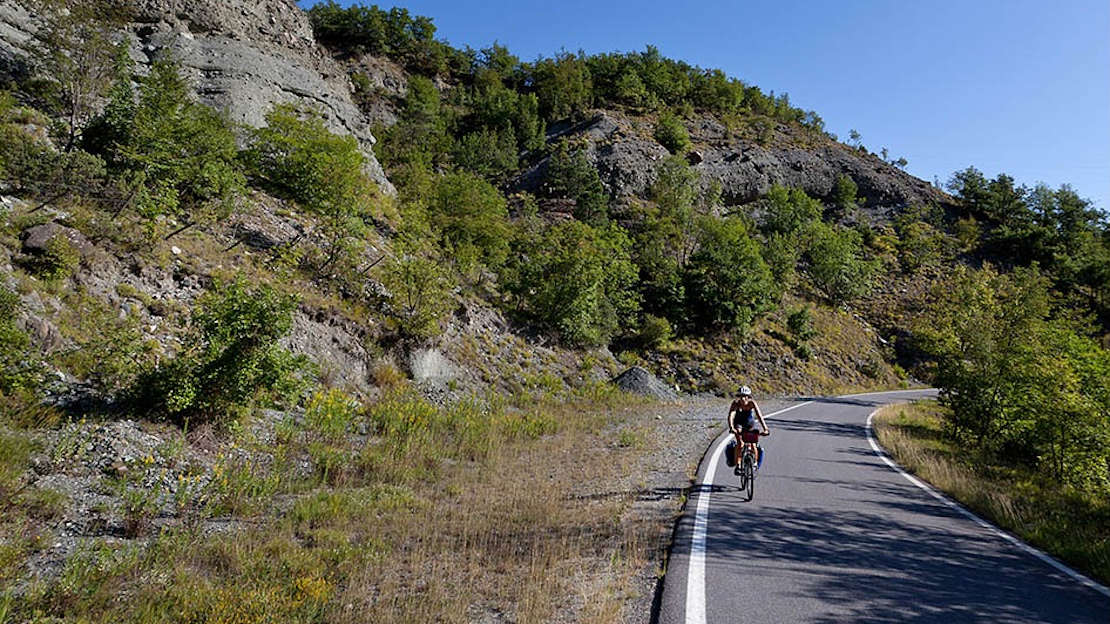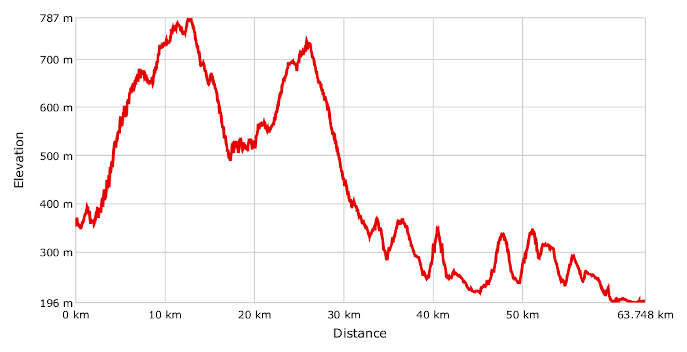
- Bike: strada/trekking
- Difficulty: ***
- Distance: 64 km
- Altitude difference: 591 m
- Total ascent: 1482 m
- Total descent: 1482 m

The idea of including the main routes in the history of the Resistance in the province of Alessandria and much of Monferrato in this cycling guide was inspired by the plans for the exhibition 'Sui Sentieri della Libertà' ('On the freedom paths'). This was promoted by the historical institute ISRAL (Istituto per la Storia della Resistenza e della Società Contemporanea in Provincia di Alessandria) in collaboration with ANPI (Associazione Nazionale Partigiani d’Italia), as well as other historical institutes. The Nazis and Fascists committed atrocities in many places. We will only touch on the most prominent. The most tragic in Alto Monferrato was the Benedicta massacre, near the Capanne di Marcarolo, between 6 and 11 April 1944. Ninety-eight partisans from the Garibaldi Brigades were summarily executed by National Republican Guard and German units. A hundred fell in combat or were executed in Masone, Voltaggio and Isoverde and at the passes of Turchino and Mezzano. A further 206 were deported (and only a very few returned). By happy chance, about 200 managed to escape from the train taking them to concentration camps. Many farmers paid a high price, too. Some paid with their lives or were tortured, and many farms were burned down.
Our tour begins on the Apennine peaks, on the paths of the Resistance. We set off at G. Marconi railway station in Campo Ligure, a transit village for the army and partisan brigades, and immediately start climbing up the old paths, now small tarmac roads, on the peaks of the Ponzema valley. After a climb of about 11 km, interrupted by the occasional short slope, we reach the SP 167, where we turn left and reach the Capanne di Marcarolo natural park. Past Rifugio Nido del Biancone, Trattoria degli Olmi and the church of Santa Croce, we cross the highest point on the tour, at an altitude of 787 m. Soon after having started our descent, we reach an area with facilities at the ruins of Benedicta, a farmhouse, nowadays situated at the heart of the Spinola-Pizzorno estate, was a Benedictine abbey in the Middle Ages. It was blasted with dynamite in the spring of 1944, after the big round-up of Germans and Fascists in the Apennines in Liguria and Alessandria. Today, all that remains to remind us of what happened at the farmhouse are ruins and historical records. After an obligatory stop at the memorial, go downhill for almost 5 km and follow, over hills and slopes, the river Gorzente, until you start climbing again at Valico Eremiti. The route climbs to 28 km, where, finally, we go downhill again towards the Bosio residential area. The town was awarded the War Cross for Military Valour for the sacrifice made by its residents and its active role in the partisan fight in World War II. From here, continue towards Carrosio, hometown of the partisan commander Giancarlo Odino, born in Genoa in 1894, died at the Turchino pass in 1944 and awarded a Gold Medal for Military Valour. Make a turn and climb to the village of Pratolungo di Gavi, with its commemorative plaque to the partisan Carlo Denegri, captured in the countryside between Gavi and Arquata Scrivia and slaughtered on the spot by Fascists in the winter of 1944. Once at the top of the hamlet, the route backs up on itself. Turn around and go downhill for about 4 km, to reach Gavi. The fort of Gavi is one of the most important sites in the history of the province of Alessandria and in the development of military architecture in Piedmont. During World War II, this ancient fortress was used by the Nazis and Fascists as a military prison. It was attacked several times by partisans attempting to free the prisoners. Enter Gavi's residential area, developed around the 11th-century church of San Giacomo, and reach Piazza Dante, where there is a commemorative plaque to the martyrs of the Benedicta. In the town cemetery, a marble monument commemorates the prisoners who died in the fort's prison cells. On to the final stretch, crossing the SP 162, once a trail in the woods leading to the Scrivia valley and now a small tarmac road. Exit the thick woods, which used to shelter the partisans, into the sun, and from the small church of Monterotondo keep following the road to Novi Ligure.
Novi Ligure was a major centre of industry and the railways in southern Piedmont, and during the war was the target of several heavy Allied bombings.
Between 14 and 19 June 1940, French bombers reached Novi and hit the Mossi aviation field, on the route to Alessandria. During the last phase of the war, Allied air raids caused heavy material damage, as well as scores of victims among Novi's inhabitants. On 4 June 1944, the railway yard and workshops were seriously damaged. On 8 July, the area around the railway station was hit by death and destruction, with a tragic death count of more than 100 civilians.
Many reminders of the Novi Resistance can be found here. Following the track, the first stop is in Piazza XX Settembre, the threshold to the evocative town centre, where a plaque commemorates Mario Balustra, 19 years old when he died and awarded a Silver Medal for Military Valour. He was the last partisan to die in the liberation of Novi, killed whilst fighting the retreating Germans. Past the railway, take Via G. Verdi and Via Casteldragone to reach Boccardo middle school, on Via A. Ferrando Scrivia, where a marble monument commemorates the six partisans who fell, weapons in their hands, on 26 April 1945, in the countryside around Cascina Tuara. Resume the tour and take Via A. Molinari Bruno, Via Concordia and Via G. Verdi to Piazzale Leoni di Liguria and the former Giorgi barracks, where there is a memorial to the Italian soldiers of the 157th Liguria infantry. Stationed in the town, they fought on various World War II fronts. Go around a big building, firstly from Via Nizza and then from Corso Italia, to reach the Garibaldi Gardens on Viale Partigiani, where a monument celebrates the local Resistance. The route ends at the town railway station in Piazza Falcone e Borsellino. From here, if you so wish, you can return to the starting point by train, with a biglietto bici al seguito, a ticket that allows you to take your bike on.
